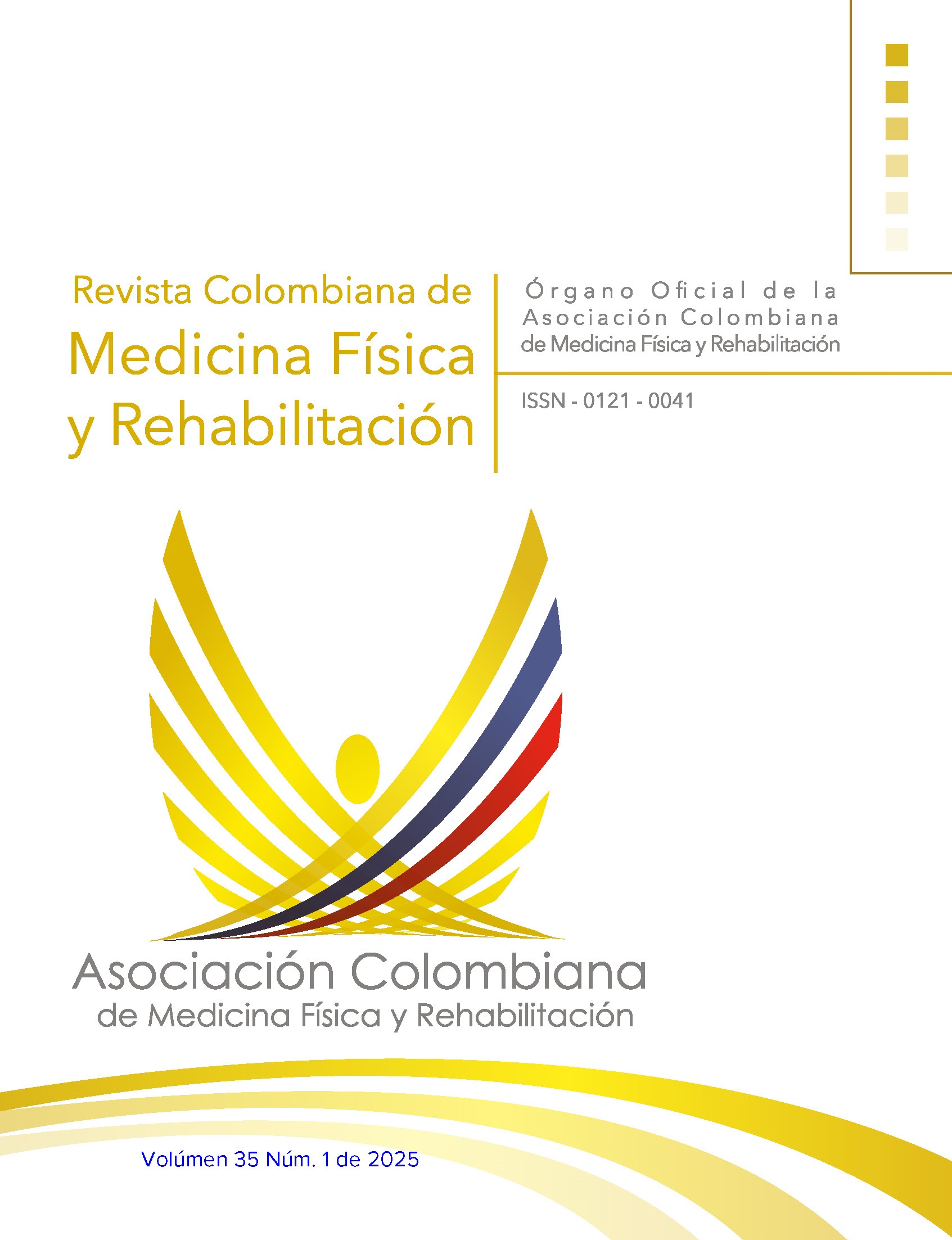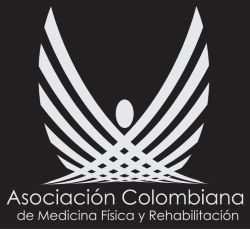Characterization of physiological changes in residual limb volume in transtibial amputees
DOI:
https://doi.org/10.28957/rcmfr.441Keywords:
Amputation, prosthesis and implants, amputation stumps, leg traumaAbstract
Introduction. Amputations are events that can have physical, psychological, and occupational consequences on individuals. In Colombia, these represent an important cause of physical limitation and are mainly associated with armed conflict.
Objectives. To characterize changes in stump volume in a group of patients with transtibial amputations who began the prosthetic fitting process at a hospital in Bogotá D.C. (Colombia); to identify possible factors associated with these changes and their time or occurrence; and to establish specific times for measuring the stump volume during the prosthetic adaptation process.
Methods. A prospective study was conducted with a series of cases that included adult patients (>18 years) diagnosed with transtibial amputation and who began the prosthetic fitting process at the Prosthetics and Amputee Service of the Central Military Hospital (Hospital Militar Central) of Bogotá D.C. between January 2022 and June 2023. The personal data of the participants, who were assessed on four occasions in which their stump length and circumference were measured and 3D scanned to calculate the stump volume, were recorded. A descriptive analysis was performed using the R statistical software. The data are described using absolute and relative frequencies for qualitative variables, and measures of central tendency and dispersion for quantitative variables.
Results. A total of 20 participants were included, all men, with a mean age of 34.66 years. 95% of the amputations were caused by an improvised explosive device, 75% were in the left leg and 60% had cylindrical morphology. A significant association was found between the time of use of the prosthesis and the activity level of the patient. It will be observed that changes in the volume, length and circumference of the stump do not follow a uniform pattern and vary between individuals; However, in the stumps of bulbous morphology, only reductions in volume were observed, without an increase in measurements. No significant associations were found between sociodemographic characteristics of the participants and changes in stump volume.
Conclusion. No sociodemographic factor or condition was identified as having a significant effect on stump volume changes. In addition, it was not possible to establish specific variability values or predict when changes in the stump volume will occur; therefore, it was not possible to establish specific times to perform measurement of the stump.
References
Organización Mundial de la Salud (OMS). Discapacidad. Ginebra: OMS; 2023 [citado junio 30 de 2025]. Disponible en: https://www.who.int/es/news-room/fact-sheets/detail/disability-and-health.
Dillingham TR, Pezzin LE, MacKenzie EJ. Limb amputation and limb deficiency: epidemiology and recent trends in the United States. South Med J. 2002;95(8):875-83. Disponible en: https://doi.org/10.1097/00007611-200208000-00018.
Colombia. Ministerio de Salud y Protección Social (Minsalud). Guía de práctica clínica para el diagnóstico y tratamiento preoperatorio, intraoperatorio y postoperatorio de la persona amputada, la prescripción de la prótesis y la rehabilitación integral. Guía No. 55. Bogotá D.C.: Minsalud; 2015.
Colombia. Dirección para la Acción Integral contra Minas Antipersonal. Datos abiertos. Registro de información de afectación por MAP y MUSE e intervención. Fecha de corte: 31 de enero de 2024. Bogotá D.C.: Acción Contra Minas; 2024 [citado junio 19 de 2025]. Disponible en: https://www.accioncontraminas.gov.co/Estadisticas.
Esquenazi A, DiGiacomo R. Rehabilitation after amputation. J Am Podiatr Med Assoc. 2001;91(1):13-22. Disponible en: https://doi.org/10.7547/87507315-91-1-13.
Gallagher P, MacLachlan M. Development and psychometric evaluation of the Trinity Amputation and Prosthesis Experience Scales (TAPES). Rehabilitation Psychology. 2000;45(2):130-154. Disponible en: https://doi.org/10.1037/0090-5550.45.2.130.
Fortington LV, Geertzen JH, van Netten JJ, Postema K, Rommers GM, Dijkstra PU. Short and long term mortality rates after a lower limb amputation. Eur J Vasc Endovasc Surg. 2013;46(1):124-31. Disponible en: https://doi.org/10.1016/j.ejvs.2013.03.024.
Burger H, Marincek C. Return to work after lower limb amputation. Disabil Rehabil. 2007;29(17):1323-9. Disponible en: https://doi.org/10.1080/09638280701320797.
Colombia. Dirección para la Acción Integral contra Minas Antipersonal. Situación víctimas minas antipersonal en Colombia. Bogotá D.C.: Acción Contra Minas; 2023.
Gailey R, Allen K, Castles J, Kucharik J, Roeder M. Review of secondary physical conditions associated with lower-limb amputation and long-term prosthesis use. J Rehabil Res Dev. 2008;45(1):15-29. Disponible en: https://doi.org/10.1682/jrrd.2006.11.0147.
Larsen BG, McLean JB, Allyn KJ, Brzostowski JT, Garbini JL, Sanders JE. How do transtibial residual limbs adjust to intermittent incremental socket volume changes? Prosthet Orthot Int. 2019;43(5):528-39. Disponible en: https://doi.org/10.1177/0309364619864771.
Chui KK, Jorge M, Yen SC, Lusardi MM. Orthotics and prosthetics in rehabilitation. 4th ed. St. Louis: Elsevier; 2020.
Sanders JE, Youngblood RT, Hafner BJ, Ciol MA, Allyn KJ, Gardner D, et al. Residual limb fluid volume change and volume accommodation: relationships to activity and self-report outcomes in people with trans-tibial amputation. Prosthet Orthot Int. 2018;42(4):415-27. Disponible en: https://doi.org/10.1177/0309364617752983.
Sanders JE, Fatone S. Residual limb volume change: systematic review of measurement and management. J Rehabil Res Dev. 2011;48(8):949-86. Disponible en: https://doi.org/10.1682/jrrd.2010.09.0189.
Kofman R, Beekman AM, Emmelot CH, Geertzen JHB, Dijkstra PU. Measurement properties and usability of non-contact scanners for measuring transtibial residual limb volume. Prosthet Orthot Int. 2018;42(3):280-7. Disponible en: https://doi.org/10.1177/0309364617736088.
Resnik L, Borgia M. Reliability of outcome measures for people with lower-limb amputations: distinguishing true change from statistical error. Phys Ther. 2011;91(4):555-65. Disponible en: https://doi.org/10.2522/ptj.20100287.
Tantua AT, Geertzen JH, van den Dungen JJ, Breek JK, Dijkstra PU. Reduction of residual limb volume in people with transtibial amputation. J Rehabil Res Dev. 2014;51(7):1119-26. Disponible en: https://doi.org/10.1682/JRRD.2013.11.0243.
Zachariah SG, Saxena R, Fergason JR, Sanders JE. Shape and volume change in the transtibial residuum over the short term: preliminary investigation of six subjects. J Rehabil Res Dev. 2004;41(5):683-94. Disponible en: https://doi.org/10.1682/jrrd.2003.10.0153.
Murphy D. Fundamentals of amputation care and prosthetics. New York: Demos Medical; 2013.
Kelly BM, Spires MC, Restrepo JA. Orthotic and prosthetic prescriptions for today and tomorrow. Phys Med Rehabil Clin N Am. 2007;18(4):785-858. Disponible en: https://doi.org/10.1016/j.pmr.2007.08.001.
McLean JB, Redd CB, Larsen BG, Garbini JL, Brzostowski JT, Hafner BJ, et al. Socket size adjustments in people with transtibial amputation: effects on residual limb fluid volume and limb-socket distance. Clin Biomech (Bristol). 2019;63:161-71. Disponible en: https://doi.org/10.1016/j.clinbiomech.2019.02.022.
Lindner HYN, Nätterlund BS, Hermansson LMN. Upper Limb Prosthetic Outcome Measures: Review and Content Comparison Based on International Classification of Functioning, Disability and Health. Prosthet Orthot Int. 2010;34(2):109-128. Disponible en: https://doi.org/10.3109/03093641003776976.
Board WJ, Street GM, Caspers C. A comparison of trans-tibial amputee suction and vacuum socket conditions. Prosthet Orthot Int. 2001;25(3):202-209.
Laferrier JZ, Gailey R. Advances in lower-limb prosthetic technology. Phys Med Rehabil Clin N Am. 2010;21(1):87-110. Disponible en: https://doi.org/10.1016/j.pmr.2009.08.003.
Ziegler-Graham K, MacKenzie EJ, Ephraim PL, Travison TG, Brookmeyer R. Estimating the prevalence of limb loss in the United States: 2005 to 2050. Arch Phys Med Rehabil. 2008;89(3):422-429. Disponible en: https://doi.org/10.1016/j.apmr.2007.11.005.
Parvizi J, Kim GK. Amputation of the lower limb. In: Parvizi J, editor. High yield orthopaedics. Philadelphia: Elsevier; 2010. p. 17-19.
Pirouzi G, Abu Osman NA, Eshraghi A, Ali S, Gholizadeh H, Wan Abas WA. Review of the socket design and interface pressure measurement for transtibial prosthesis. ScientificWorldJournal. 2014;2014:849073. Disponible en: https://doi.org/10.1155/2014/849073.
Cutson TM, Bongiorni DR. Rehabilitation of the older lower limb amputee: a brief review. J Am Geriatr Soc. 1996;44(11):1388-1393.
Disponible en: https://doi.org/10.1111/j.1532-5415.1996.tb01415.x.
Kristinsson O. The ICEROSS concept: a discussion of a philosophy. Prosthet Orthot Int. 1993;17(1):49-55. Disponible en: https://doi.org/10.3109/03093649309164354.
World Medical Association (WMA). WMA Declaration of Helsinki – Ethical principles for medical research involving human participants. Helsinki: 75th WMA General Assembly; 2024 [citado junio 22 de 2025]. Disponible en: https://bit.ly/40k4BRS.
Colombia. Ministerio de Salud. Resolución 8430 de 1993 (octubre 4): Por la cual se establecen las normas científicas, técnicas y administrativas para la investigación en salud [Internet]. Bogotá D.C.; octubre 4 de 1993 [citado junio 22 de 2025]. Disponible en: https://bit.ly/3Q3R0t8.
How to Cite
Downloads
Downloads
Published
Issue
Section
License
Copyright (c) 2025 Revista Colombiana de Medicina Física y Rehabilitación

This work is licensed under a Creative Commons Attribution-NonCommercial-NoDerivatives 4.0 International License.

| Article metrics | |
|---|---|
| Abstract views | |
| Galley vies | |
| PDF Views | |
| HTML views | |
| Other views | |


